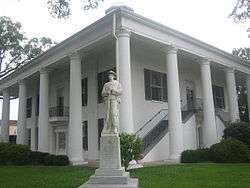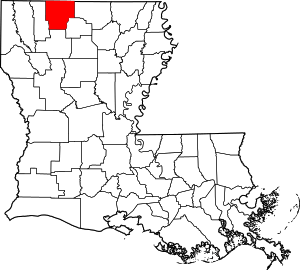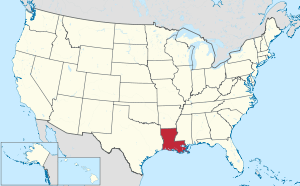Claiborne Parish, Louisiana
Claiborne Parish (French: Paroisse de Claiborne) is a parish located in the northwestern section of the U.S. state of Louisiana. The parish was formed in 1828,[1] and was named for the first Louisiana governor, William C. C. Claiborne. As of the 2010 census, the population was 17,195.[2] The parish seat is Homer.[3]
Claiborne Parish | |
|---|---|
Parish | |
| Parish of Claiborne | |
 The Claiborne Parish Courthouse was built in 1860 in Greek style. It served as a point of departure for Confederate troops. | |
 Location within the U.S. state of Louisiana | |
 Louisiana's location within the U.S. | |
| Coordinates: 32°49′N 92°59′W | |
| Country | |
| State | |
| Founded | March 15, 1828 |
| Named for | William C. C. Claiborne |
| Seat | Homer |
| Largest town | Homer |
| Area | |
| • Total | 767 sq mi (1,990 km2) |
| • Land | 755 sq mi (1,960 km2) |
| • Water | 13 sq mi (30 km2) 1.6% |
| Population (2010) | |
| • Total | 17,195 |
| • Estimate (2018) | 15,944 |
| • Density | 22/sq mi (8.7/km2) |
| Time zone | UTC−6 (Central) |
| • Summer (DST) | UTC−5 (CDT) |
| Congressional district | 4th |
| Website | claiborneparish |
History
John Murrell moved his family from Arkansas to the Flat Lick Bayou area about 6 miles west of present-day Homer in 1818, and they became the first known non-natives to permanently settle in Claiborne Parish. As more settlers moved into the area, the Murrell house served as a church, school and post office. When the state legislature created Claiborne Parish out of Natchitoches Parish in 1828, all governmental business, including court, began being held in the Murrell house. This continued until the new parish's police jury selected Russellville (now a ghost town located northeast of Athens) as the parish seat.[4][5][6] As the population began swelling in what was then the western part of the parish, the seat was moved to Overton (another modern ghost town found near Minden) in 1836, because of its position at the head of the navigable portion of Dorcheat Bayou. Due to flooding and health concerns, the parish seat was moved to Athens in 1846, but an 1848 fire destroyed the courthouse and all the records in it. Soon thereafter the Claiborne Police Jury chose the present site for the parish seat, which came to be named, Homer.[7]
John Ardis Cawthon of Louisiana Tech University studied several Claiborne Parish ghost towns in his book of local history, Ghost Towns of Old Claiborne. He recalls the words of a relative, George Washington Dance, "When the courthouse moved, the glory departed. The village is now an old worn-out field."[8]
Much of the area history is preserved in the Herbert S. Ford Memorial Museum, located across from the parish courthouse in Homer.
Government and infrastructure
Louisiana Department of Public Safety and Corrections operates the David Wade Correctional Center in an unincorporated section of Claiborne Parish near Homer and Haynesville.[9][10]
Geography
According to the U.S. Census Bureau, the parish has a total area of 767 square miles (1,990 km2), of which 755 square miles (1,960 km2) is land and 13 square miles (34 km2) (1.6%) is water.[11]
Major highways
.svg.png)




Adjacent parishes
- Columbia County, Arkansas (northwest)
- Union County, Arkansas (northeast)
- Union Parish (east)
- Lincoln Parish (southeast)
- Bienville Parish (south)
- Webster Parish (west)
National protected area
- Kisatchie National Forest (part)
Demographics
| Historical population | |||
|---|---|---|---|
| Census | Pop. | %± | |
| 1830 | 1,764 | — | |
| 1840 | 6,185 | 250.6% | |
| 1850 | 7,471 | 20.8% | |
| 1860 | 16,848 | 125.5% | |
| 1870 | 20,240 | 20.1% | |
| 1880 | 18,837 | −6.9% | |
| 1890 | 23,312 | 23.8% | |
| 1900 | 23,029 | −1.2% | |
| 1910 | 25,050 | 8.8% | |
| 1920 | 27,885 | 11.3% | |
| 1930 | 32,285 | 15.8% | |
| 1940 | 29,855 | −7.5% | |
| 1950 | 25,063 | −16.1% | |
| 1960 | 19,407 | −22.6% | |
| 1970 | 17,024 | −12.3% | |
| 1980 | 17,095 | 0.4% | |
| 1990 | 17,405 | 1.8% | |
| 2000 | 16,851 | −3.2% | |
| 2010 | 17,195 | 2.0% | |
| Est. 2018 | 15,944 | [12] | −7.3% |
| U.S. Decennial Census[13] 1790-1960[14] 1900-1990[15] 1990-2000[16] 2010-2013[2] | |||
As of the census[17] of 2000, there were 16,851 people, 6,270 households, and 4,338 families residing in the parish. The population density was 22 people per square mile (9/km²). There were 7,815 housing units at an average density of 10 per square mile (4/km²). The racial makeup of the parish was 51.80% White, 47.37% Black or African American, 0.14% Native American, 0.10% Asian, 0.03% Pacific Islander, 0.08% from other races, and 0.48% from two or more races. 0.76% of the population were Hispanic or Latino of any race.
There were 6,270 households out of which 29.70% had children under the age of 18 living with them, 47.10% were married couples living together, 17.60% had a female householder with no husband present, and 30.80% were non-families. 28.50% of all households were made up of individuals and 14.80% had someone living alone who was 65 years of age or older. The average household size was 2.50 and the average family size was 3.07.
In the parish the population was spread out with 25.60% under the age of 18, 8.00% from 18 to 24, 26.90% from 25 to 44, 22.30% from 45 to 64, and 17.30% who were 65 years of age or older. The median age was 38 years. For every 100 females there were 99.80 males. For every 100 females age 18 and over, there were 98.40 males.
The median income for a household in the parish was $25,344, and the median income for a family was $32,225. Males had a median income of $29,161 versus $20,102 for females. The per capita income for the parish was $13,825. About 21.40% of families and 26.50% of the population were below the poverty line, including 36.30% of those under age 18 and 23.20% of those age 65 or over.
Politics
With a narrow majority of African Americans in the population, Claiborne Parish in the years after the civil rights movement was primarily Democratic in political complexion. In 1988, Vice President George Herbert Walker Bush prevailed in Claiborne Parish with 3,756 votes (53.6 percent). Governor Michael S. Dukakis of Massachusetts trailed with 3,158 votes (45.1 percent).[18] In 1996, U.S. President Bill Clinton of neighboring Arkansas, obtained 3,609 votes (53.6 percent) in Claiborne Parish. Republican Bob Dole of Kansas polled 2,500 votes (37.1 percent).[19]
However, by 2008, U.S. Senator John McCain of Arizona easily carried the parish in his losing race to Barack H. Obama. McCain polled 3,750 votes (54.8 percent) to Obama's 3,025 votes (44.2 percent).[20] In 2012, Mitt Romney carried the parish, with 3,649 votes (54.2 percent), nearly identical to the McCain tally four years earlier. President Obama received 3,014 votes (44.8 percent), or .6 of 1 percent greater than his earlier tabulation.[21]
| Year | Republican | Democratic | Third parties |
|---|---|---|---|
| 2016 | 55.8% 3,585 | 42.3% 2,717 | 1.9% 119 |
| 2012 | 54.2% 3,649 | 44.8% 3,014 | 1.0% 69 |
| 2008 | 54.8% 3,750 | 44.2% 3,025 | 1.0% 66 |
| 2004 | 55.9% 3,704 | 43.1% 2,854 | 1.1% 72 |
| 2000 | 53.9% 3,384 | 43.3% 2,721 | 2.8% 176 |
| 1996 | 37.1% 2,500 | 53.6% 3,609 | 9.3% 630 |
| 1992 | 37.2% 2,599 | 46.6% 3,263 | 16.2% 1,134 |
| 1988 | 53.6% 3,756 | 45.1% 3,158 | 1.3% 93 |
| 1984 | 60.3% 4,349 | 38.7% 2,788 | 1.1% 77 |
| 1980 | 50.0% 3,538 | 48.7% 3,443 | 1.3% 93 |
| 1976 | 51.8% 3,216 | 46.6% 2,891 | 1.6% 100 |
| 1972 | 64.1% 3,432 | 29.0% 1,551 | 7.0% 373 |
| 1968 | 18.7% 1,117 | 25.9% 1,545 | 55.4% 3,311 |
| 1964 | 89.0% 3,917 | 11.0% 482 | |
| 1960 | 34.7% 1,336 | 12.7% 489 | 52.7% 2,029 |
| 1956 | 53.6% 2,084 | 20.8% 810 | 25.5% 992 |
| 1952 | 64.6% 2,796 | 35.4% 1,530 | |
| 1948 | 9.5% 265 | 16.4% 457 | 74.1% 2,064 |
| 1944 | 20.3% 578 | 79.7% 2,266 | |
| 1940 | 5.8% 187 | 94.2% 3,049 | |
| 1936 | 5.4% 146 | 94.5% 2,563 | 0.1% 2 |
| 1932 | 2.2% 61 | 97.8% 2,765 | |
| 1928 | 13.8% 249 | 86.2% 1,560 | |
| 1924 | 4.1% 54 | 95.9% 1,252 | |
| 1920 | 3.8% 48 | 96.2% 1,216 | |
| 1916 | 1.2% 15 | 98.8% 1,276 | 0.1% 1 |
| 1912 | 1.2% 10 | 92.2% 785 | 6.6% 56 |
Education
Claiborne Parish School Board serves the parish.
Claiborne Academy is a private institution in an unincorporated area in the parish, near Haynesville.[23]
Communities
Towns
- Haynesville
- Homer (parish seat and largest municipality)
Villages
Unincorporated communities
- Arizona
- Lake Claiborne
- Marsalis
- Russellville
- Summerfield
Notable people
Prominent Claiborne Parish residents include or have included:
- Alfred Goodwill, landowner in Claiborne Parish who in 1880 established the largest general store in Louisiana in Minden in Webster Parish[24]
- T. H. Harris, pioneer educator and state education superintendent from 1908 to 1940, was born in the Arizona community in Claiborne Parish in 1869, the son of a Baptist minister. Another Claiborne Parish educator, John Sparks Patton, once ran against Harris for education superintendent and himself served on the Louisiana Public Service Commission until he was unseated in 1942 by Jimmie Davis. Patton is remembered for his crusade to establish taxpayer-funded school textbooks.
- Andrew R. Johnson was a state senator from Claiborne and Bienville parishes from 1916 to 1924. He was previously the mayor of Homer and introduced electric lights and water works to the community.
- John Sidney Killen, state representative for Claiborne Parish in 1871; placed in Webster Parish with its creation from Claiborne Parish, had farm and cattle operation north of Minden[25]
- Joe LeSage, state senator for Caddo Parish from 1968 to 1972; Shreveport attorney born in Homer[26]
- George H. Mahon, Former U.S. Representative
- James T. McCalman, state senator from Claiborne and Bienville parishes from 1960 to 1964.
- Enos C. McClendon, Jr., judge of the Louisiana 26th Judicial District Court based in Minden; Homer native.
- Danny Roy Moore of Homer and later Arcadia in Bienville Parish is a former member of the Louisiana State Senate, with service from 1964 to 1968.
- Dave L. Pearce, Louisiana Commissioner of Agriculture and Forestry from 1952-1956 and 1960-1976, was born in Claiborne Parish in 1904 but later served in the state legislature from West Carroll Parish.
- Larry Sale, sheriff of Claiborne Parish from 1936 to 1944; bodyguard at the assassination of Huey Pierce Long Jr.[27]
- Richard Stalder, former secretary of the Louisiana Department of Public Safety and Corrections, is a former warden at David Wade Correctional Center in Homer.
- David Wade, Lieutenant General of the United States Air Force, former commander of Barksdale Air Force Base, state corrections director and adjutant general, was reared in the Holly Springs community of Claiborne Parish.[28]
- Loy F. Weaver, a retired banker who served in the Louisiana House of Representatives from 1976 to 1984.[29]
- Mule Watson, pitcher in Major League Baseball from 1918–24, was born in Arizona, Louisiana in Claiborne Parish.
- Pinkie C. Wilkerson represented Claiborne Parish in the state House from 1992, having defeated Kenneth Volentine in the 1991 general election. She served until her death in a six-vehicle accident in Bossier City on August 1, 2000.[30] Volentine was subsequently elected sheriff in 1995 and 1999.
Patrick Floyd Garrett, Sheriff of Lincoln County New Mexico, and killer of Billy the Kid, lived here as a child, the family having moved from Alabama to Louisiana in late 1850s
Frederick Douglass "Fred" Lewis, resident of Lisbon, was one of the first three African-Americans elected to serve on the Claiborne Parish School Board. He was the president of the civil rights organization known as the Claiborne Parish Civic League from 1965-1973. Lewis led the organization in filing a 1972 lawsuit that improved the lives of African-Americans in Claiborne Parish. Mr. Lewis's contributions helped the Friendship CME Church of Lisbon to be listed on May 31, 2016 in the National Register of Historic Places.
Frederick "Fred" Kirkpatrick was from Haynesville. He made an impact in the United States as an athlete, educator, civil rights activist, minister, and folksinger during the 1960s and 1970s. Most notably, Rev. Kirkpatrick was co-founder of the Deacons for Defense and Justice. The Deacons protected prominent civil rights activists when they visited the South, and they protected black families during the 1960s era of cross burnings and harassment. Fred Kirkpatrick received his Bachelor's Degree from Grambling State University where he also played football.
Gallery
- Begun by Ruth Gantt Prince (1928-2014) and owned and operated by Daniel and Caitlin Prince, the Port-au-Prince Restaurant on Louisiana Highway 146 at Lake Claiborne specializes in catfish. The Princes are opening a second similar restaurant on Cross Lake in Shreveport.[31]
- Rolled hay in a farm field north of Athens (May 2010)
- Typical of parts of rural Louisiana is this abandoned house in western Claiborne Parish.
- There is a Trinity Southern Methodist Church in Homer and a Claiborne Southern Methodist congregation, a conservative theological body separate from the United Methodists, located north of Homer.
- Holly Springs Baptist Church west of Homer on U.S. Highway 79 is among rural congregations in Claiborne Parish. It has maintained a small cemetery since 1952 located across the highway from the sanctuary.
References
- Harris, D. W.; Hulse, B. M. (1886). The History of Claiborne Parish, Louisiana. New Orleans, LA: W. H. Stansbury & Company. Retrieved September 3, 2014.
- "State & County QuickFacts". United States Census Bureau. Retrieved August 20, 2013.
- "Find a County". National Association of Counties. Archived from the original on 2011-05-31. Retrieved 2011-06-07.
- Burr, Murphy J. "Murrell family pioneered in Claiborne Parish". www.thepineywoods.com/. The Piney Woods Journal. Retrieved 14 December 2014.
- Volentine, Linda; Herring, Susan T. "Bridges Mill School Remembered". The Guardian-Journal. Retrieved 15 December 2014.
- Herring, Susan T. (29 April 1999). ""Father Of Claiborne Parish" John Murrell Arrived In August Of 1819". www.usgwarchives.net/. The Guardian-Journal. Retrieved 15 December 2014.
- Harris, D. W.; Hulse, B. M., eds. (1886). The History of Claiborne Parish, Louisiana, From Its Incorporation in 1828 to the Close of the Year 1885. New Orleans: W. B. Stansbury & Co. pp. 19–20, 103.
- "Russellville: Ghost Town of Claiborne Parish". claiborneone.org. Archived from the original on July 7, 2010. Retrieved July 8, 2010.
- "David Wade Corr. Center Archived 2011-01-27 at the Wayback Machine." Louisiana Department of Public Safety and Corrections. Accessed September 14, 2008.
- "Inmate wants his privileges restored." The Advocate. January 11, 1990. Retrieved on October 2, 2010. "But Mule was transferred to Wade Correctional Center in Haynesville[...]"
- "2010 Census Gazetteer Files". United States Census Bureau. August 22, 2012. Archived from the original on September 28, 2013. Retrieved August 27, 2014.
- "Population and Housing Unit Estimates". Retrieved October 29, 2019.
- "U.S. Decennial Census". United States Census Bureau. Retrieved August 27, 2014.
- "Historical Census Browser". University of Virginia Library. Retrieved August 27, 2014.
- "Population of Counties by Decennial Census: 1900 to 1990". United States Census Bureau. Retrieved August 27, 2014.
- "Census 2000 PHC-T-4. Ranking Tables for Counties: 1990 and 2000" (PDF). United States Census Bureau. Retrieved August 27, 2014.
- "U.S. Census website". United States Census Bureau. Retrieved 2011-05-14.
- "Claiborne Parish presidential election returns, November 8, 1988". staticresults.sos.la.gov. Retrieved November 11, 2012.
- "Claiborne Parish presidential election returns, November 5, 1996". staticresults.sos.la.gov. Retrieved November 11, 2012.
- "Claiborne Parish presidential election returns". staticresults.sos.la.gov. Retrieved November 11, 2012.
- "Claiborne Parish presidential election returns, November 6, 2012". staticresults.sos.la.gov. Retrieved November 11, 2012.
- Leip, David. "Dave Leip's Atlas of U.S. Presidential Elections". uselectionatlas.org. Retrieved 2018-03-07.
- "image007.gif Archived 2011-06-27 at the Wayback Machine." Claiborne Academy. Retrieved on October 2, 2010. "6741 Highway 19, Haynesville, LA 71038."
- "Capt. Alfred Goodwill". findagrave.com. Retrieved March 12, 2015.
- "John Killen Home". Minden Memories. Archived from the original on July 18, 2011. Retrieved March 16, 2015.
- "Joe C. LeSage, Jr., obituary". The Shreveport Times. September 24, 2015. Retrieved September 27, 2015.
- Exhibit, Herbert S. Ford Memorial Museum, Homer, Louisiana
- Wade Room, Herbert S. Ford Memorial Museum, Homer, Louisiana
- "Membership in the Louisiana House of Representatives, 1812-2012" (PDF). house.louisiana.gov. Archived from the original (PDF) on March 31, 2010. Retrieved September 5, 2009.
- "State Rep. Wilkerson Killed in Auto Accident". house.legis.state.la.us. August 1, 2000. Archived from the original on March 6, 2011. Retrieved September 26, 2009.
- "Restaurant inspired by popular Lake Claiborne eatery coming to Cross Lake". Shreveport Times. Retrieved February 14, 2014.